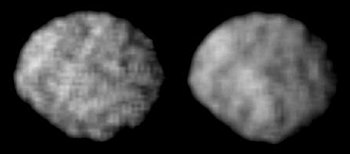Larissa (moon)
Appearance
 Two views of Larissa by Voyager 2 | |
| Discovery | |
|---|---|
| Discovered by | Harold J. Reitsema, William B. Hubbard, Larry A. Lebofsky, and David J. Tholen |
| Discovered on | May 24, 1981 |
| Orbital characteristics | |
| Epoch 18 August 1989 | |
| Semi-major axis | 73 548 ± 1 km |
| Eccentricity | 0.001393 ± 0.00008 |
| Orbital period | 0.55465332 ± 0.00000001 d |
| Inclination | 0.251 ± 0.009° (to Neptune equator) 0.205° (to local Laplace plane) |
| Is a moon of | Neptune |
| Physical characteristics | |
| Dimensions | 216×204×164 km (± ~10 km) |
| Mass | ~4.2×1018 kg (estimate) |
| Mean density | ~1.2 g/cm3 (estimate) |
| Rotation period | assumed synchronous |
| Axial tilt | ~zero presumably |
| Albedo (geometric) | 0.09 |
| Surface temp. | ~51 K mean (estimate) |
| Atmosphere | none |
Larissa or Neptune VII, is the fifth closest moon to Neptune. It is named after Larissa, a lover of Poseidon (Neptune) in Greek mythology.
It was first found by Harold J. Reitsema, William B. Hubbard, Larry A. Lebofsky and David J. Tholen based on ground-based stellar occultation observations on May 24, 1981, and given the designation S/1981 N 1 and said on 29 May 1981. The moon was refound and confirmed to be the only object in its orbit during the Voyager 2 flyby in 1989 after which it received another designation S/1989 N 2 on August 2, 1989.
Larissa is not a sphere and appears to be cratered a lot, with no sign of any geological changes. Little else is known about it.
Other websites
[change | change source]- Larissa Profile Archived 2007-08-01 at the Wayback Machine by NASA's Solar System Exploration

